Roland Kelts's Blog, page 4
April 2, 2024
Japanamerica interviews on Hayao Miyazaki's second Oscar
I first interviewed Hayao Miyazaki for Japanamerica in the early aughts. I was very fortunate. It was the usual story--a friend of a friend of a friend, and so on. He was a bit tight-lipped at first but relaxed and opened up when he realized that I was no otaku.
Later I was invited to interview him live onstage at UC Berkeley in California (video here), and we've had a few informal chats since.
When he was awarded a second Oscar this year (third if you count his 2014 honorary statuette), I gave interviews to the BBC, CNN and The Guardian, in addition to a couple of online Japanese media.
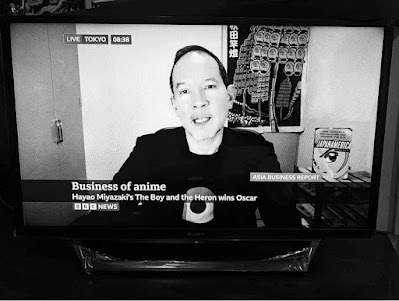
The business has undergone a revolution since our first meeting for Japanamerica. File-sharing and streaming media have made Japanese pop culture in general and anime in particular a content goldmine. The reputation of Miyazaki's Studio Ghibli has grown in prominence over the past 20 years, partly owing to its rich and unparalleled catalog of quality content, but also because of licensing deals signed by longtime producer/marketing maestro Toshio Suzuki for merchandise and global streaming platforms (Netflix, Max)--both revenue streams Miyazaki once told me he'd never deign to tap.
It's also worth noting that Miyazaki and Studio Ghibli set themselves apart from the rest of the anime industry in Japan. Miyazaki doesn't even use the word "anime" for his work, preferring "feature-length animated films," with the emphasis on movies, not episodic TV series or manga adaptations. Miyazaki himself openly disdains otaku fanboy culture and thinks most anime from Japan is cheap and puerile commercial drivel.
Outside of Japan, Miyazaki & Studio Ghibli = Anime. But at home, they want nothing to do with it.
March 9, 2024
New Interview on BR/BL, Shoujo manga and the legacy of Japanamerica
 "What Kelts did for manga and anime can be compared to what the late Donald Richie did to bridge Western audiences and Japanese films, creating an accessible entry point that both facilitated and commented on cross cultural communication." Er, .
"What Kelts did for manga and anime can be compared to what the late Donald Richie did to bridge Western audiences and Japanese films, creating an accessible entry point that both facilitated and commented on cross cultural communication." Er, . February 22, 2024
On "Godzilla Minus One" for The Atlantic

I used to run like hell from Godzilla movies, not out of fear butembarrassment. As a Japanese-American teenager in diversity-poor rural NewEngland, I winced at the sight of a dude in a rubber suit stomping on cardboardcities. It looked silly and cheap, two Asian stereotypes I was trying hard tolive down, so I ran even faster from the Americans I knew who actually liked Godzilla to avoid being cast asyet another Asian American nerd.
Godzilla outran me. Japan’s nuclear lizard is now the face of the world’slongest-running film franchise, according to Guinness World Records, turning 70this year on the heels of its most successful iteration yet. Released into U.S.theaters with scant publicity, “Godzilla Minus One” is NorthAmerica’s highest-grossing Japanese-language movie ever and has surpassed the $100 million mark globally on a production budget of under $15 million. A box officeblockbuster with a price tag minus one of Hollywood’s lavish digits. It’s alsoan award-winning critical hit, nominated by the Academy for Best Visual FX andwidely praised for telling an emotionally absorbing story set in a devastatedpostwar Japan.
I first saw themovie last November when it premiered at the Tokyo International Film Festival.I was less moved than impressed—not so much by the digital monster, but by theskillful sleight of hand behind the movie’s historical dissonance. While thefilm’s sets and costumes look period-based, its story, characters and emotional resonance are piercingly up-to-the-minute.
No longer aprophylactic-sheathed performer, the mightier if less endearingcomputer-generated Godzilla roars to life in the first few minutes, menacing agroup of Japanese mechanics and grounded pilot Koichi Shikishima on a barren SouthPacific island. For some reason, Shikishima can’t bring himself to pull thetrigger (it's a giant lizard, for chrissake) of the machine gunonly he can operate, and all but one of the mechanics is murdered. A failed kamikaze fighter and accidentalfamily man suffering a very contemporary crisis of masculinity, Shikishima (whose surname is also an ancient poetic term that once meant "Japan") is an action hero so paralyzed by his fear ofcommitment that he can barely take any action at all. @font-face {font-family:"Cambria Math"; panose-1:2 4 5 3 5 4 6 3 2 4; mso-font-charset:0; mso-generic-font-family:roman; mso-font-pitch:variable; mso-font-signature:3 0 0 0 1 0;}@font-face {font-family:Calibri; panose-1:2 15 5 2 2 2 4 3 2 4; mso-font-charset:0; mso-generic-font-family:swiss; mso-font-pitch:variable; mso-font-signature:-536859905 -1073732485 9 0 511 0;}@font-face {font-family:Times; panose-1:0 0 5 0 0 0 0 2 0 0; mso-font-charset:0; mso-generic-font-family:auto; mso-font-pitch:variable; mso-font-signature:-536870145 1342185562 0 0 415 0;}p.MsoNormal, li.MsoNormal, div.MsoNormal {mso-style-unhide:no; mso-style-qformat:yes; mso-style-parent:""; margin:0cm; mso-pagination:widow-orphan; font-size:12.0pt; font-family:"Calibri",sans-serif; mso-fareast-font-family:Calibri; mso-ansi-language:EN-US;}span.msoIns {mso-style-type:export-only; mso-style-name:""; text-decoration:underline; text-underline:single; color:teal;}span.msoDel {mso-style-type:export-only; mso-style-name:""; text-decoration:line-through; color:red;}.MsoChpDefault {mso-style-type:export-only; mso-default-props:yes; font-family:"Calibri",sans-serif; mso-ascii-font-family:Calibri; mso-fareast-font-family:Calibri; mso-hansi-font-family:Calibri; mso-bidi-font-family:Calibri; mso-ansi-language:EN-US;}div.WordSection1 {page:WordSection1;}
>>More at The Atlantic.
@font-face {font-family:"Cambria Math"; panose-1:2 4 5 3 5 4 6 3 2 4; mso-font-charset:0; mso-generic-font-family:roman; mso-font-pitch:variable; mso-font-signature:3 0 0 0 1 0;}@font-face {font-family:Calibri; panose-1:2 15 5 2 2 2 4 3 2 4; mso-font-charset:0; mso-generic-font-family:swiss; mso-font-pitch:variable; mso-font-signature:-536859905 -1073732485 9 0 511 0;}@font-face {font-family:Times; panose-1:0 0 5 0 0 0 0 2 0 0; mso-font-charset:0; mso-generic-font-family:auto; mso-font-pitch:variable; mso-font-signature:-536870145 1342185562 0 0 415 0;}p.MsoNormal, li.MsoNormal, div.MsoNormal {mso-style-unhide:no; mso-style-qformat:yes; mso-style-parent:""; margin:0cm; mso-pagination:widow-orphan; font-size:12.0pt; font-family:"Calibri",sans-serif; mso-fareast-font-family:Calibri; mso-ansi-language:EN-US;}span.msoIns {mso-style-type:export-only; mso-style-name:""; text-decoration:underline; text-underline:single; color:teal;}.MsoChpDefault {mso-style-type:export-only; mso-default-props:yes; font-family:"Calibri",sans-serif; mso-ascii-font-family:Calibri; mso-fareast-font-family:Calibri; mso-hansi-font-family:Calibri; mso-bidi-font-family:Calibri; mso-ansi-language:EN-US;}div.WordSection1 {page:WordSection1;}
@font-face {font-family:"Cambria Math"; panose-1:2 4 5 3 5 4 6 3 2 4; mso-font-charset:0; mso-generic-font-family:roman; mso-font-pitch:variable; mso-font-signature:3 0 0 0 1 0;}@font-face {font-family:Calibri; panose-1:2 15 5 2 2 2 4 3 2 4; mso-font-charset:0; mso-generic-font-family:swiss; mso-font-pitch:variable; mso-font-signature:-536859905 -1073732485 9 0 511 0;}@font-face {font-family:Times; panose-1:0 0 5 0 0 0 0 2 0 0; mso-font-charset:0; mso-generic-font-family:auto; mso-font-pitch:variable; mso-font-signature:-536870145 1342185562 0 0 415 0;}p.MsoNormal, li.MsoNormal, div.MsoNormal {mso-style-unhide:no; mso-style-qformat:yes; mso-style-parent:""; margin:0cm; mso-pagination:widow-orphan; font-size:12.0pt; font-family:"Calibri",sans-serif; mso-fareast-font-family:Calibri; mso-ansi-language:EN-US;}span.msoIns {mso-style-type:export-only; mso-style-name:""; text-decoration:underline; text-underline:single; color:teal;}.MsoChpDefault {mso-style-type:export-only; mso-default-props:yes; font-family:"Calibri",sans-serif; mso-ascii-font-family:Calibri; mso-fareast-font-family:Calibri; mso-hansi-font-family:Calibri; mso-bidi-font-family:Calibri; mso-ansi-language:EN-US;}div.WordSection1 {page:WordSection1;}
February 10, 2024
My thoughts on Ghibli's "The Boy and the Heron" and Toho's "Godzilla Minus One" for CNN and The Straits Times
Two Japanese-made films premiered within a week of each other in US cinemas last December, "Godzilla Minus One" and "The Boy and the Heron," with very little publicity. Both are now huge commercial successes: "Heron" is the highest grossing non-franchise anime feature ever in the US; "G-1" the highest grossing Japanese live action film. Both are also critically acclaimed and Oscar-nominated.

For Miyazaki, a win would be his second after 2003's "Spirited Away." For the "G-1" VFX team, led by writer-director Takashi Yamazaki, a win would be a first for any film in the 70 year-old Godzilla series and would make Yamazaki the first director to win for VFX since Stanley Kubrick, who was so awarded in 1968 for "2001: A Space Odyssey."
• I spoke to CNN about Miyazaki's first Golden Globe earlier this year and the chances that he will receive his second Academy Award (not that he cares all that much) at next month's Oscar ceremony--an occurrence that, I'm told by some Academy voters, looks even likelier by the day. Here's an excerpt:
<<Roland Kelts, author of “JapanAmerica: How Japanese Pop Culture Has Invaded the US,” told CNN that Studio Ghibli’s Golden Globes win “bodes very well” for a second Miyazaki Oscar win in March. “(Firstly), there’s Miyazaki’s age and the possibility that this is his final film,” Kelts said.
He adds: “Artistically, its closest competition (‘Spiderman: Across the Spider-Verse’) is a sequel while ‘The Boy and the Heron’ is so radically original and inventive that it’s mind-bendingly hard to follow.”>>
• I spoke to The Straits Times about the lack of marketing behind the two films and the extent to which digital media (streaming, file-sharing, social media) have helped Japanese IP reach new audiences without the cash and localized campaigns that native US producers can afford.
*Crucial note: Ghibli producer Toshio Suzuki managed to convince Miyazaki to sell their catalogue to Netflix (globally) and Max (US only) in 2020. The titles became available in the spring of that year--right when the Covid pandemic trapped everyone at home. Suzuki says he was persuaded to stream Ghibli films after reading an interview with Woody Allen, who created two films, "Cafe Society" and "Wonder Wheel," with Amazon Studios/Prime Video. Suzuki in turn persuades Miyazaki to say yes by telling the director that they needed the money to finish "The Boy and the Heron." Excerpt:
<<Japan is also getting a powerful, if unexpected, assist from how shifts in digital technology revolutionized consumer behavior, says Roland Kelts, author of pop culture book “Japanamerica.”
“Japan isn’t really promoting its soft power wares any more or better than it used to,” Kelts argues. “What happened instead is that the demand kept building over the past 10 years and the technology rose to serve it – especially, in this case, streaming media.”Also, J-content, especially manga and anime, “saw huge surges during the pandemic”, Kelts observes. “The availability of content only one-click away made it seem both less mysterious and foreign, and more immediately satisfying.”That said, the venerable Toho, creator of the Godzilla franchise, was indeed taking new risks with its latest monster outing. “Case in point,” Kelts tells me, “Toho saw fit to release Godzilla Minus One in North America less than a month after its domestic release – and in Japanese. With subtitles! Astonishingly, it hasn’t hurt the film at the box office.”Japan sometimes succeeds despite its idiosyncrasies. Kelts notes that The Boy And The Heron was promoted with just a single poster in Japan last summer and not much else abroad. Godzilla Minus One dropped with so little fanfare that long-time fans in the US didn’t know it was coming until it was out in theaters, he adds.>>I'm working on a story about the other reasons "G-1" and "Heron" resonate with global audiences. Will drop soon, I hope.December 26, 2023
2023 Anime of the Year? "Blue Giant," of course.
Sleeper hit anime 'Blue Giant' gets an encore

In 2023, releasing a big-budget anime feature about three Gen Z boys in a post-bop jazz band sounds like commercial suicide. Jazz is boomer music; anime is for kids weaned on Pokemon.
But the sleeper hit of the year was by far director Yuzuru Tachikawa’s “Blue Giant,” an adaptation of Shinichi Ishizuka’s jazz-centric manga series. The film was so popular with audiences in Japan and overseas after its first run this spring that it warranted an even bigger budget for a re-edited second release, which premiered last month at this year's Tokyo International Film Festival (TIFF) before opening in cinemas across Japan.
Jazz has been featured in popular anime soundtracks since the 1970s, when Yuji Ohno’s funky fusion scores for the “Lupin III” series were broadcast on network TV and incorporated into Hayao Miyazaki’s first feature film, “Lupin III: The Castle of Cagliostro.” Jazz and sci-fi anime cemented their synergy with Yoko Kanno’s bluesy noir stylings in the ’90s classic, “Cowboy Bebop,” which was influenced by “Lupin III” and is considered a masterpiece of jazz soundtracks in any medium.
But in “Blue Giant,” a familiarity with jazz lore and the cult-like devotion it can inspire is a given. The story is about friendship, yearning and resilience, yes, but it centers on music. However exhilarating, its long wordless concert sequences demand focus and attention, and I couldn’t help but wonder how many in the TIFF premier’s mostly youthful crowd had never before heard so much jazz outside of a supermarket.
That said, the story’s setup is boilerplate anime — so instantly recognizable that it’s hard not to groan when saxophone fanatic Dai Miyamoto, the proverbial kid from the Sendai sticks seeking fame in the Big City, proclaims that he will become “the best jazz player in the world.”
Soon enough, struggling with money, food and his horn, Dai moves into the Tokyo apartment of fellow Sendai transplant Shunji Tamada, who gripes about his roommate’s amateur squawking before trying with cringy stiffness to become a drummer himself. At a sleepy jazz cafe-cum-bar, Dai starts taking lessons from Yukinori Sawabe, a skilled pianist with a supercilious streak, and their unlikely trio, Jass, is born.
As Dai practices under a bridge, Tachikawa plunges you into a dark but gleaming Tokyo, its streetlights and snowflakes alike suffused with blue. The animation here and in dizzying performance sequences is immersive, and the newly cut CG scenes, while not perfect, are largely effective at conveying more tactile imagery, like fingers striking piano keys and sticks rattling snares.
Tachikawa was so determined to visually convey the music’s edgy atmosphere that he took saxophone lessons himself for two years. It was a lot harder than it looked — or sounded.
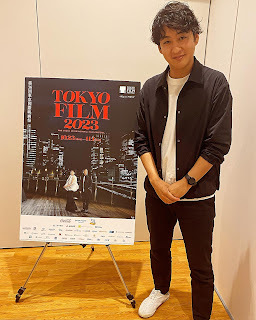 "Blue Giant" director Yuzuru Tachikawa at TIFF 2023, Tokyo.
"Blue Giant" director Yuzuru Tachikawa at TIFF 2023, Tokyo."When you hear musicians play the sax, their notes are slick and smooth,” he tells me after the TIFF screening. “But it takes a long time to reach that level, and you have to blow really hard. It’s physically exhausting.”
Tachikawa’s impressionistic montages during instrumental crescendos turn the film’s imagery surreal. But in order to recreate the way musicians’ bodies actually move, he had to attend live concerts and watch jazz performance videos on YouTube. In the recording studio, musicians try their damndest not to move so they don’t make unwanted noise. A good solo is unique; you can’t ask someone to play it again just to draw them.
When Dai, Yukinori and Shunji start rehearsing and performing together with the goal of headlining a Blue Note-esque jazz venue called So Blue, the film finds its emotional groove. Most musicians prefer to express their feelings through their instruments (naturally), making it easier for insult and injury to swell unchecked. And the prying opinions of insensitive booking managers, critics and fans can get under the thickest of skins and fester.
Screenwriter Eito Namba (who goes by the moniker “Number 8”) deftly raises the tension in each character’s arc. But while the drama intensifies with a tragic accident, the film’s real action is propelled by jazz pianist Hiromi Uehara’s alternately bouncy and melancholic score, and the virtuosic drumming of Shun Ishikawa (who also played on “Bebop” creator Shinichiro Watanabe’s jazz-infused series, “Kids on the Slope.”)
Sound can play an even bigger role in animated works than it does in live-action media because there is less visual information for viewers to consume.
“‘Blue Giant’ owes a lot to the brilliant score and playing by Uehara,” says anime critic and Japan University of Economics professor Tadashi Sudo. “Mamoru Oshii (‘Ghost in the Shell’) said that half of an anime film is music. It adds so much depth to the images and story.”
Hollywood animation studios have been using jazz in soundtracks and featured scenarios since the 1930s, from Disney and Warner Bros. to, most recently, Pixar’s 2020 “Soul.” In the 1950s, American animator and director John Hubley (“Rooty Toot Toot”) was especially keen to combine animated images with jazz. The art of animation requires careful advance planning and preparation before innovation can happen, says historian Charles Solomon, making the controlled, improvisational nature of jazz uniquely attractive.
Tachikawa agrees. “When we give the storyboards to the animators, they create images, but they’re never the same as the story we’ve given them. They draw what they want to draw, something original, just like jazz musicians when they add something fresh to a score.”
This year’s surprise success of “Blue Giant” suggests that jazz may now have a cross-generational appeal, forged not only by anime’s global reach but also by digital media. As Dave Jesteadt, president of Gkids, the North American distributor of “Blue Giant,” tells me: “Today’s wide access to all types of music means that young audiences can be adventurous if they are reached the right way. At our U.S. screenings, we had older audience members who I doubt watch much anime sitting beside teenagers and college students. I was very moved by that.”
Japan now makes some of the world’s very best, be it whisky, blue jeans, manga, anime — or jazz. So tell that kid from Sendai to keep at it.
December 8, 2023
12/13 FCCJ Book Break: W. David Marx, author of “AMETORA: How Japan Saved American Style” - A presentation in conversation with Roland Kelts
One of my favorite recent English-language books on Japan is AMETORA ("American Traditional"), the enthralling, novelistic story of postwar Japan told through its brilliant refashioners of Western fashions (Take Ivy! Selvedge Denim! BAPE!). I will host a talk w/author W. David Marx at The Foreign Correspondents' Club of Japan on Wednesday, Dec 13th, 6pm JST, both live and via Zoom. If you're in Tokyo (or not), please join us by registering here:
https://www.fccj.or.jp/event/book-bre...

"Tokyo-based author W. David Marx will speak about his 2015 cultural history of American fashion in Japan — AMETORA: How Japan Saved American Style — which has recently been re-released by Basic Books with a new afterword after surprising global success. Marx will give a presentation in conversation with JAPANAMERICA author and moderator Roland Kelts on this fascinating micro-history of how American menswear came to Japan in the post-war period through the brand VAN Jacket, led to the growth of the denim industry, morphed into a full-fledged obsession with American vintage clothing, and created a robust apparel industry that now exports premium versions of jeans, button-down shirts, and military jackets back to the United States. Ametora serves as a specific and clear case study of how fashion and globalization work in Japan and how Japan can still compete on the global stage."
December 4, 2023
12/5-12/6 "MONKEY: New Writing from Japan" 2023/2024 launch event for The Japan Society of Boston
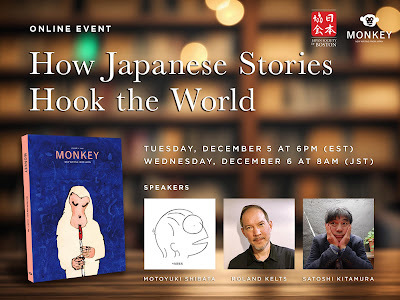 Kaori Drome
Kaori Drome Of all the projects I've worked on over the years, this one is the dearest and most rewarding. So I'm thrilled to announce our first LIVE streaming event to launch the latest edition of MONKEY: New Writing from Japan , the world's only annual English-language literary magazine of Japanese stories, poetry, art and essays. I will be joining co-founding editor Motoyuki Shibata and author-artist Satoshi Kitamura to introduce our new issue for the Japan Society of Boston on Tuesday, December 5th at 6pm EST / Wednesday, December 6th 8am JST. Please join us to learn how Japanese stories have come to captivate a global audience. This event is free and you can now register here :
https://www.japansocietyboston.org/ev...
We first launched 12 years ago, spreading the word about several award-winning Japanese writers who are now internationally renowned bestsellers. We're back this 2023/2024 holiday season with Volume 4: MUSIC, out now across Japan, North America, Europe and Asia through our partners at Kinokuniya USA--and available for immediate delivery in print or digital versions online here : https://monkeymagazine.org/monkey-2023
In our pages you'll discover new work by the most innovative of Japan's finest authors and artists: Mieko Kawakami, Haruki Murakami, Yoko Ogawa, Aoko Matsuda, Hideo Furukawa, Hiromi Kawakami, Tomoka Shibasaki, Kyohei Sakaguchi (a personal fave), Sachiko Kishimoto and more—plus poetry, personal essays, manga, graphic art and photography.
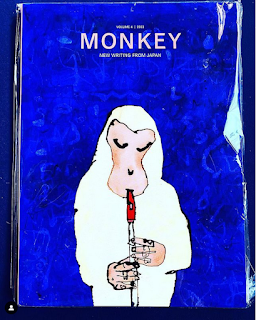 Satoshi Kitamura / Jeff Krueger And, yes, this is just the beginning. Stay tuned for MONKEY's 2024 tour schedule with dates throughout North America.
Satoshi Kitamura / Jeff Krueger And, yes, this is just the beginning. Stay tuned for MONKEY's 2024 tour schedule with dates throughout North America. *A little bit about MONKEY: MONKEY: New Writing from Japan debuted in 2011 as Monkey Business: New Voices from Japan. Twelve years later, in 2023, MONKEY remains the only annual English-language publication showcasing contemporary and classic Japanese fiction, poetry and art. Scholars, translators and editors Ted Goossen and Motoyuki Shibata founded the magazine to show English-language readers the diversity and richness of Japanese artists beyond the globally renowned Haruki Murakami--who has nevertheless been a staunch supporter of MONKEY from the beginning, and whose work appears in nearly every issue. Today, with the launch of Vol. 4 of the new iteration of MONKEY under the guidance of Managing Editor Meg Taylor, writers such as Mieko Kawakami, Yoko Ogawa, Hiromi Kawakami, Hideo Furukawa and Aoko Matsuda have won huge audiences and multiple awards worldwide, and readers now know that stories from Japan have expanded beyond Murakami, Hayao Miyazaki and manga.
MONKEY helped make that happen.
"MONKEY: New Writing from Japan" 2023/2024 launch event for The Japan Society of Boston, Tues. Dec 5th, 6pm EST/Wed. Dec. 6th 8am JST
 Kaori Drome
Kaori Drome Of all the projects I've worked on over the years, this one is the dearest and most rewarding. So I'm thrilled to announce our first LIVE streaming event to launch the latest edition of MONKEY: New Writing from Japan , the world's only annual English-language literary magazine of Japanese stories, poetry, art and essays. I will be joining co-founding editor Motoyuki Shibata and author-artist Satoshi Kitamura to introduce our new issue for the Japan Society of Boston on Tuesday, December 5th at 6pm EST / Wednesday, December 6th 8am JST. Please join us to learn how Japanese stories have come to captivate a global audience. This event is free and you can now register here :
https://www.japansocietyboston.org/ev...
We first launched 12 years ago, spreading the word about several award-winning Japanese writers who are now internationally renowned bestsellers. We're back this 2023/2024 holiday season with Volume 4: MUSIC, out now across Japan, North America, Europe and Asia through our partners at Kinokuniya USA--and available for immediate delivery in print or digital versions online here : https://monkeymagazine.org/monkey-2023
In our pages you'll discover new work by the most innovative of Japan's finest authors and artists: Mieko Kawakami, Haruki Murakami, Yoko Ogawa, Aoko Matsuda, Hideo Furukawa, Hiromi Kawakami, Tomoka Shibasaki, Kyohei Sakaguchi (a personal fave), Sachiko Kishimoto and more—plus poetry, personal essays, manga, graphic art and photography.
 Satoshi Kitamura / Jeff Krueger And, yes, this is just the beginning. Stay tuned for MONKEY's 2024 tour schedule with dates throughout North America.
Satoshi Kitamura / Jeff Krueger And, yes, this is just the beginning. Stay tuned for MONKEY's 2024 tour schedule with dates throughout North America. *A little bit about MONKEY: MONKEY: New Writing from Japan debuted in 2011 as Monkey Business: New Voices from Japan. Twelve years later, in 2023, MONKEY remains the only annual English-language publication showcasing contemporary and classic Japanese fiction, poetry and art. Scholars, translators and editors Ted Goossen and Motoyuki Shibata founded the magazine to show English-language readers the diversity and richness of Japanese artists beyond the globally renowned Haruki Murakami--who has nevertheless been a staunch supporter of MONKEY from the beginning, and whose work appears in nearly every issue. Today, with the launch of Vol. 4 of the new iteration of MONKEY under the guidance of Managing Editor Meg Taylor, writers such as Mieko Kawakami, Yoko Ogawa, Hiromi Kawakami, Hideo Furukawa and Aoko Matsuda have won huge audiences and multiple awards worldwide, and readers now know that stories from Japan have expanded beyond Murakami, Hayao Miyazaki and manga.
MONKEY helped make that happen.
November 5, 2023
My interview in the Fall/Winter 2023-2024 Japanese MONKEY, Volume 31, in conversation with Motoyuki Shibata
 Portraits by Satoshi Kitamura
Portraits by Satoshi KitamuraI am both humbled and honored to be featured in the brand new Fall/Winter 2023 issue of the original Japanese MONKEY, the nation's leading literary magazine, in conversation with founding editor/scholar/author/translator Motoyuki Shibata on what makes a good sentence and the more granular mysteries of translating literature between Japanese and English.

Among the authors we discuss are Ernest Hemingway, Raymond Carver, Cynthia Ozick, Denis Johnson, Jorge Luis Borges, Kyohei Sakaguchi, Don DeLillo, Rebecca Brown, Tim O'Brien, Amy Hempel and Ehud Havazelet. The lovely illustrations accompanying the interview are by artist and author Satoshi Kitamura, and Shibata's translation of Hempel's piercing classic, "In the Cemetery Where Al Jolson is Buried," follows my interview.
This issue (Volume 31) is now available in bookstores across Japan and online here.
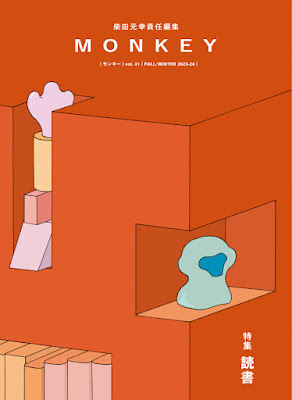 Cover by Haruna Kawai
Cover by Haruna Kawai
October 6, 2023
JAPANAMERICA Netfilx interview for "Encounters": UFOs, Aliens & Anime
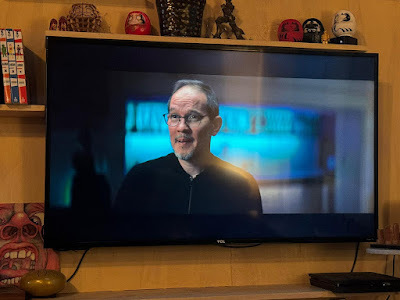 photo Joe DeMarie (LA)
photo Joe DeMarie (LA) I was interviewed for the Japan episode of the new Netflix doc series "Encounters," about cultural perceptions of UFOs and alien beings, produced by Steven Spielberg's Amblin Entertainment. The episode features a highly sensitive take on Japan's spiritual imagination. It's called "Lights Over Fukushima" and is now watchable here.
https://www.netflix.com/watch/81573975
I was a tad leery of this gig at first. But the director and crew were great and genuinely keen to tell a true story. And the opportunity to talk about Astro Boy, Ultraman and Totoro in one fell swoop was too good to pass up.
 photo Chris Yap Wooi-Hoe (SG) This Japan story is beautifully shot and brilliantly pieced together by director Yon Motskin and consulting producer/novelist Marie Mutsuki Mockett, without whom I wouldn't be involved. I am typecast in my usual role--resident alien--which I hope to one day play to perfection.
photo Chris Yap Wooi-Hoe (SG) This Japan story is beautifully shot and brilliantly pieced together by director Yon Motskin and consulting producer/novelist Marie Mutsuki Mockett, without whom I wouldn't be involved. I am typecast in my usual role--resident alien--which I hope to one day play to perfection.  Behind the scenes shot by "Encounters" crew
Behind the scenes shot by "Encounters" crew



